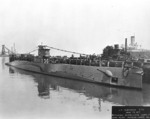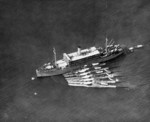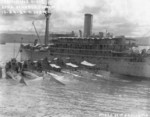S-36
| Country | United States |
| Ship Class | S-class Submarine |
| Hull Number | SS-141 |
| Builder | Bethlehem San Francisco Shipyard |
| Laid Down | 10 Dec 1918 |
| Launched | 3 Jun 1919 |
| Commissioned | 4 Apr 1923 |
| Sunk | 21 Jan 1942 |
| Displacement | 868 tons standard; 1,079 tons submerged |
| Length | 219 feet |
| Beam | 21 feet |
| Draft | 16 feet |
| Speed | 14 knots |
| Crew | 42 |
| Armament | 1x4in/50 deck gun, 4x21in torpedo tubes |
| Submerged Speed | 11 knots |
Contributor: C. Peter Chen
ww2dbaseCommissioned in 1923, S-36 operated along the west coast of the United States until summer of 1925, and then with the US Asiatic Fleet from Nov 1925 through the outbreak of WW2 in Asia. Between Apr and Jun 1940, she conducted her final deployment to Chinese waters. In early Dec 1941, due to the possibility of war between US and Japan, a scheduled overhaul for S-36 was canceled, and she sailed north from Cavite Navy Yard near Manila, Philippine Islands to Bolinao harbor, where she would be located at the time of the Japanese raid on Pearl Harbor in the Hawaiian Islands. She was immediately dispatched to patrol waters between Cape Bolinao and San Fernando, and she spotted Japanese reconnaissance aircraft. After suffering a number of mechanical problems, she ended her patrol at Mariveles Bay, Philippine Islands, where she would receive repairs and supplies. During her second war patrol, she claimed to have sunk a Japanese transport in the South China Sea close to the coast of Mindoro, but Japanese records did not reflect a loss at that position on that day. On 15 Jan 1942, in the Sulu Sea, she was spotted by a Japanese destroyer. She dove, but oil supply failures with the starboard engine slowed her down. By the time she submerged and attempted to maneuver to an attack position, the Japanese destroyer had already begun dropping depth charges. Shockwaves from the depth charges caused damage, and engine trouble continued to haunt her, but the crew was able to keep the ship under control until the Japanese destroyer gave up the hunt. She began heading toward the Makassar Strait toward Java, Dutch East Indies. At 0404 on 20 Jan 1942, after a series of mechanical failures over the past few days, she ran aground on Taka Bakang Reef at the southern end of Makassar Strait. The crew attempted to save the ship, but flooded forward battery emitted poisonous chlorine gas, and it prevented effective damage control. Meanwhile, the commanding officer Lieutenant John McKnight, Jr. sent out a request for aid over plain language unencrypted radio. On the next day, Dutch launch Attla arrived from Makassar, picking up two officers and 28 crewmembers, while McKnight and a number of others remained in a final attempt to save the submarine. Shortly after noon, Dutch cargo ship Siberote arrived. McKnight gave the order to board Siberote and abandon S-36. The submarine was scuttled at 1330 hours. Siberote sailed to Makassar, picked up those who had arrived via Attla, and delivered them to Surabaya, Java, Dutch East Indies where they would rejoin the US Navy.
ww2dbaseSource: Wikipedia
Last Major Revision: Dec 2022
Submarine S-36 (SS-141) Interactive Map
Photographs
 |  |  |  |
S-36 Operational Timeline
| 10 Dec 1918 | The keel of S-36 was laid down at the Bethlehem Shipbuilding Corporation shipyard in San Francisco, California, United States. |
| 3 Jun 1919 | S-36 was launched at the Bethlehem Shipbuilding Corporation shipyard in San Francisco, California, United States, sponsored by Miss Helen Russell. |
| 4 Apr 1923 | S-36 was commissioned into service. |
| 4 Nov 1925 | S-36 arrived at the Submarine Base, Cavite Navy Yard, Luzon, Philippine Islands. |
| 2 Dec 1941 | A scheduled overhaul for S-36 at Cavite Navy Yard, Luzon, Philippine Islands was canceled due to the possibility of war. |
| 1 Jan 1942 | S-36 fired a torpedo at a transport during the day in the South China Sea. She claimed to have sank the ship, but Japanese records did not reflect a loss at that position on that day. |
| 8 Jan 1942 | S-36 suffered a failure with the port engine air compressor. |
| 10 Jan 1942 | S-36 suffered some problems with the starboard engine air compressor. |
| 12 Jan 1942 | S-36 patrolled the Sulu Sea. |
| 13 Jan 1942 | S-36 suffered a failure with the port main motor while in the Sulu Sea. |
| 14 Jan 1942 | S-36 patrolled the Sulu Sea. |
| 15 Jan 1942 | USS S-36 spotted a Japanese destroyer off Dutch Borneo at 0500 hours, but was discovered by the destroyer, which attacked with depth charges, severely damaging the submarine. |
| 15 Jan 1942 | S-36 was spotted by a Japanese destroyer in the Sulu Sea. Oil supply failures with the starboard engine delayed her dive, and as the result she suffered damage from depth charges. |
| 16 Jan 1942 | S-36 neared the coast of Celebes (Sulawesi), Dutch East Indies in the morning. At noon, she suffered a fire in the main motor auxiliary circulating pump. By the evening, she had entered the Makassar Strait west of Celebes. |
| 17 Jan 1942 | S-36 received orders to proceed to Surabaya, Java, Dutch East Indies. Later in the day, both port and starboard shafts suffered failures, and one crew member collapsed from heat exhaustion. |
| 20 Jan 1942 | USS S-36 became stuck on Taka Bakang Reef in the Makassar Strait between British Borneo and Celebes, Dutch East Indies at 0400 hours. |
| 20 Jan 1942 | S-36 ran aground on Taka Bakang Reef at the southern end of Makassar Strait at 0404 hours. |
| 21 Jan 1942 | In the morning, Dutch launch Attla picked up 30 members of S-36's crew at the southern end of Makassar Strait, while commanding officer Lieutenant John McKnight, Jr. led a small group in a final attempt to save the ship which had ran aground on the previous day. After noon, Dutch cargo ship Siberote arrived. McKnight gave the order to board Siberote and abandon S-36. The submarine was scuttled at 1330 hours. |
| 21 Jan 1942 | Dutch motor launch Attla embarked the crew of USS S-36, which became stuck on Taka Bakang Reef in the Makassar Strait between British Borneo and Celebes, Dutch East Indies on the prior date. |
| 3 Dec 1942 | S-36 departed Cavite Navy Yard, Luzon, Philippine Islands at 0100 hours for what would become her first war patrol. She sailed north and entered Bolinao harbor at 1930 hours. |
| 9 Dec 1942 | S-36 developed excessive air leaks, but remained on patrol. |
| 10 Dec 1942 | S-36 received a message noting that her base, the Cavite Navy Yard in the Philippine Islands, had been attacked. |
| 12 Dec 1942 | S-36 suffered a problem with its electrical steering. |
| 13 Dec 1942 | S-36 suffered a leak with the exhaust valve. |
| 14 Dec 1942 | S-36 received an urgent radio message requesting her position. |
| 16 Dec 1942 | S-36 was ordered to Mariveles Bay, Philippine Islands. |
| 20 Dec 1942 | S-36 arrived at Mariveles Bay, Philippine Islands, ending her first war patrol. |
| 30 Dec 1942 | S-36 departed Mariveles bay, Philippine Islands for her second war patrol. |
Did you enjoy this article or find this article helpful? If so, please consider supporting us on Patreon. Even $1 per month will go a long way! Thank you. Share this article with your friends: Stay updated with WW2DB: |
» S-36 Submarine Operations Research Group Attack Data
- » 1,150 biographies
- » 337 events
- » 43,917 timeline entries
- » 1,241 ships
- » 350 aircraft models
- » 207 vehicle models
- » 374 weapon models
- » 123 historical documents
- » 260 facilities
- » 470 book reviews
- » 28,540 photos
- » 432 maps
James Forrestal, Secretary of the Navy, 23 Feb 1945
Please consider supporting us on Patreon. Even $1 a month will go a long way. Thank you!
Or, please support us by purchasing some WW2DB merchandise at TeeSpring, Thank you!